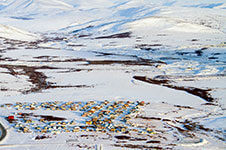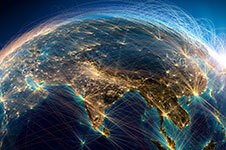While many people rely on the internet for everyday activities, the 2019 US Census found that approximately 10% of Americans have no internet access. Americans living in urban areas often have multiple choices for internet service, including fiber optic, DSL, cable, satellite, and fixed wireless, but rural locations are limited to what systems are available in their location. For some areas of the world, like rural communities in Alaska, there may only be one or two options for internet, and many times, these choices may not be affordable nor reliable.
Although Subsea fiber optic cables can be a challenge to install, they are necessary for building a fast, dependable internet system that rural areas can depend on. Fiber optic cables come with many benefits: low latency, high bandwidth, and better service are just a few. These cables are an essential component of Quintillion’s fiber optic cable network, which not only includes 1200 miles of subsea fiber but also 500 miles of terrestrial fiber.
What Are Subsea Fiber Optic Cables?
Fiber optic cables are made from bundles of optical fiber — a thin, flexible strand of pure silica glass. These strands often contain three layers, including a core, cladding, and coating. A single fiber optic cable may contain multiple optical fiber strands.
The innermost layer, the core, is about the diameter of human hair and has a high refractive index, which allows light to travel at fast speeds. The cladding wraps around the core and has a lower refractive index, which prevents light from leaking outside of the strand and bends the light back toward the core. A final layer, the coating, is placed outside the cladding to protect it from environmental factors.
These days, most of the world’s telecommunications and internet services flow through fiber optic cables. These cables can be terrestrial or subsea. Terrestrial cables are buried under the ground, whereas subsea cables are installed underneath the ocean, along the seabed, and connect at two or more landing points.
These cables are often designed with extra layers of protection and insulation to prevent water damage. They are transported and laid using cable ships, which are designed to carry thousands of miles of cable. These vessels use tools such as ploughs, television cameras, magnetometers, and depressor arms to bury the cable under the seafloor. This process has a relatively low environmental impact, relying on light rather than electricity to power, therefore offering an estimated lifetime of 25 years or more.
Challenges of Fiber Optic Cable Networks
Fiber optic cable networks can be difficult to install, and although they are designed to last a long time, environmental factors can potentially damage cables and disrupt service. In areas with rough terrain or extreme weather, laying fiber optic can be a logistical issue. For instance, in places where mountains, large ice structures, and freezing temperatures are common, such as the Alaska Arctic, it can be incredibly difficult to install both terrestrial and subsea cables.
Likewise, it also takes time to map out fiber optic routes. The bottom of the ocean is hardly flat. Instead, it is sculpted with deep valleys, mammoth mountain ranges, expansive coral reefs, and massive rocks. It takes a great deal of deep-sea exploration and engineering to identify a feasible pathway where fiber can be laid.
Additionally, anchors, fishing trawlers, and sea life can damage cables. International affairs also come into play when installing and monitoring cables, with other nations preventing plans to lay down cable or adversaries tapping subsea cables for confidential information.
Benefits of Fiber Optic Internet
Fiber optic cables are one of the main types of infrastructure used to provide broadband internet services to consumers. Fiber optic telecommunication offers several benefits including:
- High bandwidth: Fiber optics has an incredibly high bandwidth capacity, with fiber internet plans offering end-users up to 2000 Mbps.
- Decreased interference: Fiber is immune to interferences, including electromagnetic interference.
- Low latency: Latency describes how much it time it takes for a signal to travel to its destination. Fiber optics offers very low latency, especially when compared to other internet options.
- High Reliability: Clouds, rain, wind, snow, and hail are not an issue for fiber, which is not slowed or stalled by poor weather.
- Increased Speed: Fiber optic causes minimal lag and travels at about 70% the speed of light. This technology can offer speeds up to 1 Gbps, allowing users to download, upload, and process information online at a fast rate.
- Long Lifespan: Fiber optic cables have an estimated lifetime of 25 years or more. This means less money is required to maintain and update infrastructure, which results in lower costs for end-users.
The Quintillion Terrestrial and Subsea Fiber Optic Cable Network
Rural communities in Alaska are some of the most underserved communities in the United States when it comes to poor internet access. For communities living in or near the US arctic, the extreme weather conditions and icy landscape had made it essentially impossible to lay fiber optic cables in the past. However, climate change has transformed the arctic and made the difficult task of installing subsea and terrestrial fiber in the Northernmost sections of Alaska possible.
In 2017, Quintillion became the first and only telecommunications operator to build a subsea and terrestrial fiber optic cable network in the US Arctic. This extraordinary milestone has now connected 1000s of Alaskans, including an estimated 10,000 residents of rural communities, to the digital world. Broadband services were not previously available in these areas, stunting economic growth and leaving residents disconnected from other Alaskans and the rest of the world. By partnering with internet providers, such as GCI, ASTAC, DRS, Leonardo, TelAlaska, and Alaska Communication, Quintillion has been able to provide affordable and reliable broadband services to the public, with the broadband capacity to roll out LTE and 5G wireless services.
The Quintillion fiber optic cable network is well designed for the frigid, arctic conditions it was installed in. The cables themselves are incredibly resilient, and they are buried 12 feet below the seabed. They connect to six cable landings, which are each installed in steel conduits 60 to 80 feet below the ocean floor, with branching units located up to a mile offshore. Their trunk-and-branch configuration helps provide redundancy and reduce latency. Redundant equipment is at each landing station, which includes 24/7 monitoring and response. In addition, the system runs off robust power feeds, which includes a three-pair system that has 30 Tbps capacity and is scalable up to 90 Tbps.
As part of our “In,” “Out,” and “Up,” strategy, future phases of the project will extend the current Quintillion subsea and terrestrial fiber optic cable network to other parts of the world. This includes a network running from Nome, Alaska to Japan. Furthermore, we are developing a second network which will run from Prudhoe Bay, Alaska to Canada and then to Europe. Although challenges are already anticipated, we are ready to meet them head-on as we continue onward toward our mission of connecting three continents with subsea fiber.
This is just the beginning of our journey. Contact us to learn what’s in store.















